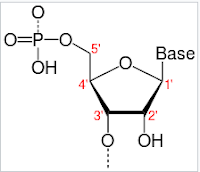Denaturation - Bascially, separate the two stands of DNA. Through various trials, scientists have found that around 94 -96°C the two strands separate while retaining their structural characteristics. Think of the double helix as a zipper and this step bassically unzips the DNA. It is important to understand that each strand of the DNA has a particular direction and for all the rest of the steps, the direction plays a very important role. I have added more details regarding the directionality to the bottom of this for those who are interested.
The zippers we are used to have ends, but in some sense they are identical. But, imagine zippers where the top and bottom stops can be one of two choices, A and B. The left side of the zipper has A and B respectively for as its top and bottom stoppers and the right side has B and A instead. It is likely to be useless as a zipper, but this is the analogy with DNA. Of course, to complicate things further, each tooth of the left zipper can be one of four choices and magically, the right zipper where the top and bottom are reversed has a tooth at every step that is complementary to the left one and they nicely come together.
----------------------------- Details that you can skip if not interested
Directionality:
As I wrote earlier, each strand has a particular direction if you look at the atomic level. At some point, the DNA that is millions of base pairs long needs to have ends. The structural characteristics of the end is used to denote diretion. Here is the depiction of a nucleotide and millions of these are connected together to form the DNA.
 |
| Credit: National Human Genome Institute |
As you can see, a nucleotode consists of a Phosphate group, a sugar molecule, and one of the bases we discussed earlier (A, T, G or C).
Now, if you look at the detailed figure, you will see a numbering system for the carbon atoms in sugar. The end of a helix where the Phosphate group looks this way (it has this OH group that is the "end") is connected to the carbon designated as 5', that is referred to as the 5' end of a strand. Similarly the O atom you see that is connected to the Carbon designated as 3' turns to OH, that will be called the 3' end.
 |
| Credit: Wikipedia |

No comments:
Post a Comment